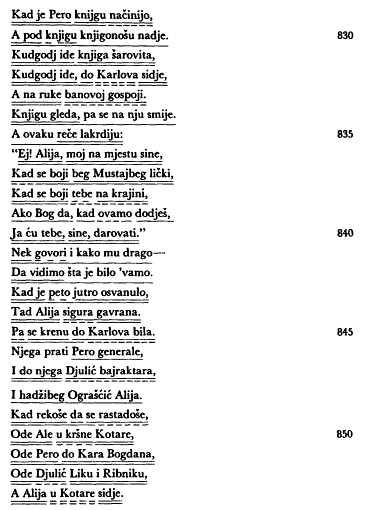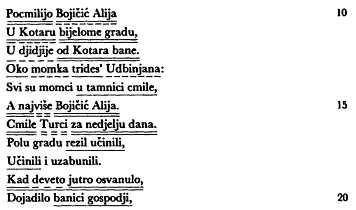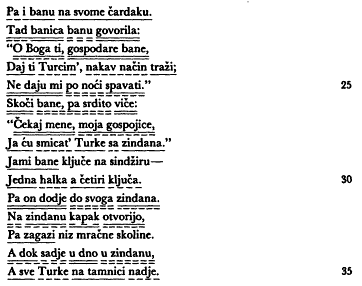A Classical Formulaic Analysis of Two Parry-Lord Texts
In order to illustrate Lord's analytical technique and to provide supplementary evidence for later discussion, I have conducted a formulaic analysis of two passages of twenty-five lines and twenty-six lines each, or a total of fifty-one deseterac verses. The passages are drawn from the performances of Stolac guslari Mujo Kukuruzovic[*] (text 1, Ropstvo Ograscic[*] Alije [The Captivity. of Ograscic[*] Alija ], Parry no. 1287a, 1,288 lines, taken from dictation) and Halil Bajgoric[*] (text 2, Halil izbavlja Bojicic[*] Aliju [Halil Rescues Bojicic[*] Alija ], Parry no. 6703, 637 lines, taken from dictation). I selected the first sample virtually at random, the sole criterion being avoidance of major recurrent themes. The second sample, however, was deliberately taken from an occurrence of a common theme in the Return Song, that of "Shouting in Prison,"[22] in order to test the formulaic density and texture of a passage governed by such a typical narrative structure.
The referent for the formulaic analysis consisted of three additional song-texts, two by Kukuruzovic[*][23] and one by Bajgoric[*][24] . All but the last song
[21] See especially M. Parry, "The Meaning of the Epithet in Epic Poetry" (1928a, in 1971, 118-72), and counterpose Parry's own insistence (p. 22) that "it does indeed give a false impression of the character of this language to imply that its creation was, so to speak, a mechanical process" and Lord (1960, 54), on the singer: "The formulaic technique was developed to serve him as a craftsman, not to enslave him." Cf. Foley 1983b.
[22] See chapter 8 below for discussion of this typical scene; for its role in the overall story-pattern, see chapter 10.
[23] Ropstvo Alagic[*] Alije (The Captivity of Alagic[*] Alija ; Parry no. 1868, 2,152 lines), taken from dictation; Ograscic[*] Alija u suzanjstvu[*] (Ograscic[*] Alija in Prison ; Parry no. 6617, 2,180 lines), sung for the records. Here and elsewhere I give standard Parry Collection titles, whether or not they seem strictly grammatical. Suppressed inflections are to be attributed to the singers' (compositional) habit of inflecting only the final element of a noun-epithet phrase, a phenomenon in turn explicable by the composite identity of the phrase as a single rec . See further chapter 3.
[24] Zenidba Becirbega[*] Mustajbegova (The Wedding of Mustajbeg's Son Becirbeg[*] ; Parry no. 6699, 1,030 lines), sung for the records. The analysis was conducted using a computerized concordance which I prepared at the Computing C. enter of the University of Massachusetts/Amherst. I am grateful to the center and to Robert P. Greed and Joel M. Halpern, who helped me to gain access to the system.
mentioned—that is, four of five texts, or 6,246 of 7,287 lines—are Return Songs, so that the selection of sample and referent generally followed the criterion of genre-dependence advocated in Chapter 1. In addition, both guslari are from the same "local tradition" of the Stolac area in southern Hercegovina, so we may reasonably expect some congruity in their individual singing styles.[25] In order to put into relief what I shall call the "idiolectal" (individual) and "dialectal" (local tradition) levels of formulaic structure (to be discussed below in the fourth section, "From Prosody to Traditional Rules"), I have purposely limited the Bajgoric[*] sample and referent to these two songs, only one of which is in the epic subgenre of Return; by comparing the density and texture of the two 25-line and 26-line passages from the two singers, we shall to an extent be able to judge the influence of the size and nature of the referent on formulaic analysis and, further, to test which phrases are shared by the two singers and which are (on available evidence) their own. Of course, figures and minor conclusions would change somewhat if the referent were enlarged or differently composed, but since we are pursuing structural principles as a basis for aesthetic inquiry rather than quantitative analysis for its own sake, we may take this configuration of texts as representative.
The first passage, that from Kukuruzovic[*] (Parry no. 1287a, lines 1.829-53), details a common enough sequence of events without involving a true theme:[26] a letter is written and delivered, and as a result a speech, preparation, and journey take place. The sample passage is marked after Parry-Lord practice, with solid underlining to indicate a formula and broken underlining to indicate a formulaic system , according to the definitions quoted above. All lines are analyzed for both whole-line and colonic units, and a literal translation of the text is provided.[27]
[25] See Lord (1960, 49), on individuals and their local tradition.
[26] Many of these events could be treated thematically by the singer, but he chooses at this point simply to relate their occurrence and not to summon the typical scenes that might be employed to express their essential narrative ideas.
[27] Supporting evidence (examples rather than an exhaustive array of related phrases) may be found in the appendix (pp. 393-94). The double underlining in the following passages and discussion indicates formulicity by colon (upper) and by whole line (lower). Although I have tried to keep this formulaic analysis as much in line with that carried out in the Odyssey passage in the last chapter as possible, tradition-dependent factors make absolute congruency inachievable. As will be shown in the extended discussion of these two passages from the Parry texts, the cola of the deseterac phraseology interact differently from the cola of the Homeric hexameter diction. Nonetheless, I have observed all the formal prescriptions set in chapter 4, counting a given colon (or hemistich) as a formula if a whole-line formula can be demonstrated, or as a system if a whole-line system can be demonstrated (unless, of course, the given colon is a formula in its own right). As we shall see below, the complexity of the diction is better rationalized by traditional rules (which are tradition-dependent) than by conventional formulaic analysis. Inevitably, the consequence of my (often legalistic) application of "formula" and "system" will not satisfy all investigators. I stress, however, that this is a shortfall in the method of formulaic analysis itself, a problem that will be with us as long as we fail to take account of the spectrum of traditional phraseology.
Text 1
When Pero formulated the letter,
Then he found a messenger for the letter. 830
Wherever the multicolored letter went,
Wherever it went, it came down to Karlovo,
And to the hand of the ban's lady.
She looked over the letter, then she laughed at it,
And spoke this word: 835
"Ej! Alija, my foster son,
Since Mustajbeg of the Lika is afraid,
Since he is afraid of you in the Krajina,
If God grants it, when you return here,
I shall give you gifts, son." 840
Let him speak as he wishes—
Let us see what is happening here.
When the fifth morning dawned,
Then Alija prepared his raven horse.
Then he started for white Karlovo. 845
General Pero followed him,
And with him Djulic[*] . the standard-bearer,
And hajibeg Ograscic[*] Alija.
When they said they would take their leave,
Alija went to rocky Kotar, 850
Pero went to Kara Bogdan,
Djulic[*] went to the Lika and to Ribnik,
And Alija came down to Kotar.
The second sample passage, that from Bajgoric[*] . (Parry no. 6703, lines 4.10-35), consists of the opening part of the ubiquitous "Shouting in Prison" theme.[28] The clamor created by the lamenting captives causes the distraught banica to petition her husband the ban for their release; he responds by entering the prison to discuss matters with the troublemakers. The same analytical procedures as were employed with the first passage are applied here.[29]
Text 2
[28] See chapter 8 for an analysis of this typical scene.
[29] The following passage consists of twenty-six (rather than twenty-five) lines because a natural subdivision occurs after 4.35.
Bojicic[*] Alija cried out 10
In the white city of Kotar,
Near the hero the ban of Kotar.
Around the young man thirty men of Udbina:
All the young men cried out in prison,
But most of all Bojicic[*] Alija. 15
The Turks cried out for a week of days.
They shamed themselves before half the city,
Shamed themselves and caused a great commotion.
When the ninth morning dawned,
It became unbearable for the lady banica, 20
And also for the ban on his porch.
Then the banica spoke to the ban:
"O by your God, master ban,
Give in to the Turks, find some way;
They do not let me sleep at night." 25
The ban jumped up, then shouted angrily:
"Await me, my dear lady,
I shall remove the Turks from the prison."
The ban seized the keys on the chain—
One ring and four keys. 30
Then he went to his prison.
He opened the cover on the prison,
Then he went down into the murky depths.
And when he reached the bottom of the prison,
He found all the Turks in the prison. 35
Formulaic analysis of the two sample passages yields the quantitative profile represented in the following list.
Passage I | Passage II | |
Colon 1 Formula | 88% | 42% |
Colon 1 System | 8% | 46% |
Colon 1 Total | 96% | 88% |
Colon 2 Formula | 80% | 46% |
Colon 2 System | 20% | 42% |
Colon 2 Total | 100% | 88% |
Both Cola Formula | 84% | 44% |
Both Cola System | 14% | 44% |
Both Cola Total | 98% | 88% |
Lines Formula | 40% | 4% |
Lines System | 48% | 50% |
Lines Total | 88% | 54% |
Most important for general purposes is the fact that both passages, the first with a larger and more homogeneous referent, and the second with a much more limited basis for comparison in the work of the singer himself, are 88 to 98 percent formulaic by colon. There are very few cola in either sample (a total of 51 lines or 102 hemistichs) that do not find a formulaic relative elsewhere in the Stolac referent. Furthermore, the Kukuruzovic[*] passage reveals a higher density of straight whole-line formulas (40 percent as compared to 25 percent) and colonic formulas (84 percent to 50 percent) than do the fifteen lines from Ugljanin examined by Lord. Even the Bajgoric[*] sample, with a much smaller idiolectal basis for comparison, shows about the same density of colonic formulas (44 percent as compared to 50 percent) as the Ugljanin passage. With virtually universal systemic structure and a high formula count, then, the figures for the Kukuruzovic[*] and Bajgoric[*] samples echo Lord's results and support his conclusions.
But there are also some differences between our two passages, and these differences start to indicate how individual styles can exist within more general traditional practice, as well as how referent size and composition can affect analysis. First, the relatively depressed figures for percentage of formulas and the relatively elevated figures for percentage of systems in the Bajgoric[*] sample may be ascribed in part to the disparity in size (1,667 versus 5,619 lines) and generic make-up (two additional Return Songs versus a Wedding Song)[30] of the referent. More significant than the formula-system ratios, however, are the nearly identical sums of these figures; no matter how many or how few cola can be established as formulas in a given context, practically all of them
[30] On epic subgenres, see chapter 1.
can be proven to be either formulas or systems. Second, the much larger difference in percentages at the whole-line level argues not for the influence of varied referents but rather for differences in individual style. Bajgoric[*] seems, relatively speaking, to eschew composition in recurrent whole lines, and especially in whole-line formulas, in favor of colonic units.[31] While both samples can be shown to be formulaic and traditional at the colonic level, then, the two singers vary widely in the extent to which they depend on whole-line formulaic phraseology. We shall look further into idiolectal characteristics and their significance in the fourth section, but it is well to note here how each guslar , while adhering in general to the traditional Stolac dialect of formulas and systems, nonetheless finds his own modus operandi within that verse dialect.


